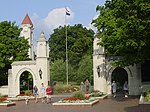Legg House | |
 Front of the house | |
| Location | 324 S. Henderson, Bloomington, Indiana |
|---|---|
| Coordinates | 39°9′49″N 86°31′39″W / 39.16361°N 86.52750°W |
| Area | 0.3 acres (0.12 ha) |
| Built | 1848 |
| Architectural style | Greek Revival |
| NRHP reference No. | 01000359[1] |
| Added to NRHP | April 12, 2001 |
The Legg House is a historic former farmhouse in Bloomington, Indiana, United States. Built in the middle of the nineteenth century, it has experienced a range of uses, culminating in its present status as an Indiana University office building. After a period of deterioration, it was restored to its original condition, and it has been designated a historic site.
Construction
[edit]
A farm occupied the present site of the Legg House at least as far back as 1820. At that time, it lay on the edge of the city; the nearby Third Street was the only road that connected Bloomington to the outside world. Landowner George M. Legg built the original portion of the house in 1848,[2] using a variant of the Greek Revival style of architecture.[1] Its construction employed local materials: the walls are built of handmade bricks, laid on a foundation of locally mined limestone, and supported with poplar beams that were cut in the Bloomington vicinity.[3] At the time of construction, it was a small house: just one story tall, it was divided into only two rooms. In later years, the house was modified significantly: a porch and frame wing were added during the 1870s, and elements throughout the house were covered during the twentieth century with elements such as drywall.[4][5]
Usage
[edit]By the early 1870s, the house had passed out of Legg's possession, being occupied by the parents and grandparents of William Lowe Bryan.[2][4] At this time, it still lay at the city's edge, but the location became more central after 1883: in that year, a fire destroyed the buildings of Indiana University at Seminary Square, and the trustees chose to move the campus to property immediately northeast of the Legg House.[4] Within a few years of the university's move, the house was converted into a boarding house, a status that it held when visited by Bryan, by that point the president of the university, in 1890.[3] This use continued into the late twentieth century; even after the university purchased the house in 1964, it was employed as student housing.[4] Insufficient funding ensured that the house was not properly maintained; it was boarded up in 1993,[2] and the university initially considered demolishing the structure before preservationists and city officials began to negotiate for its preservation.[4]
Restoration
[edit]
In April 2001, the Legg House was listed on the National Register of Historic Places, both because of its place in local history and because of its historically significant architecture.[1] Later that year, as a result of this designation,[6] the city and university were awarded a grant of $27,000 from the historic preservation division of the Indiana Department of Natural Resources,[3] and renovation began in 2002. During its nine years of vacancy, the house deteriorated greatly; although the original woodwork of the interior was in satisfactory condition, the exterior had suffered such damage as broken windows, a collapsing porch, and rotting window sills. Among the elements restored by Greenfield company Advance Restoration were the foundation, the brick chimney, and the many wooden walls; workers removed both old paint applied by previous owners and significant amounts of graffiti applied by recent vandals.[4] Today, the Legg House is actively used by Indiana University, serving as the location of the university's housing office.[7]
References
[edit]- ^ a b c "National Register Information System". National Register of Historic Places. National Park Service. March 13, 2009.
- ^ a b c Haeberle, Bennett. "University, City Team Up to Restore Historic House". Indiana Daily Student, 2001-09-05.
- ^ a b c IU, City of Bloomington Receive Grant for Historic Building Restoration Archived 2005-11-08 at the Wayback Machine, Indiana University, 2001-08-30. Accessed 2010-09-10.
- ^ a b c d e f Hinnefeld, Steve. "House To Be Restored". The Herald-Times, 2002-07-13.
- ^ "Indiana State Historic Architectural and Archaeological Research Database (SHAARD)" (Searchable database). Department of Natural Resources, Division of Historic Preservation and Archaeology. Retrieved 2016-05-01. Note: This includes Eliza Steelwater (September 2000). "National Register of Historic Places Inventory Nomination Form: Legg House" (PDF). Retrieved 2016-05-01. and Accompanying photographs.
- ^ BRI History 1996 to 2000 Archived 2011-07-25 at the Wayback Machine, Bloomington Restorations, 2010. Accessed 2010-09-11.
- ^ South Central Region, Indiana Department of Natural Resources, n.d. Accessed 2010-09-11.





